MIDWEEK UPDATE 17 JUNE 2020
Compiled by Willie Bodenstein



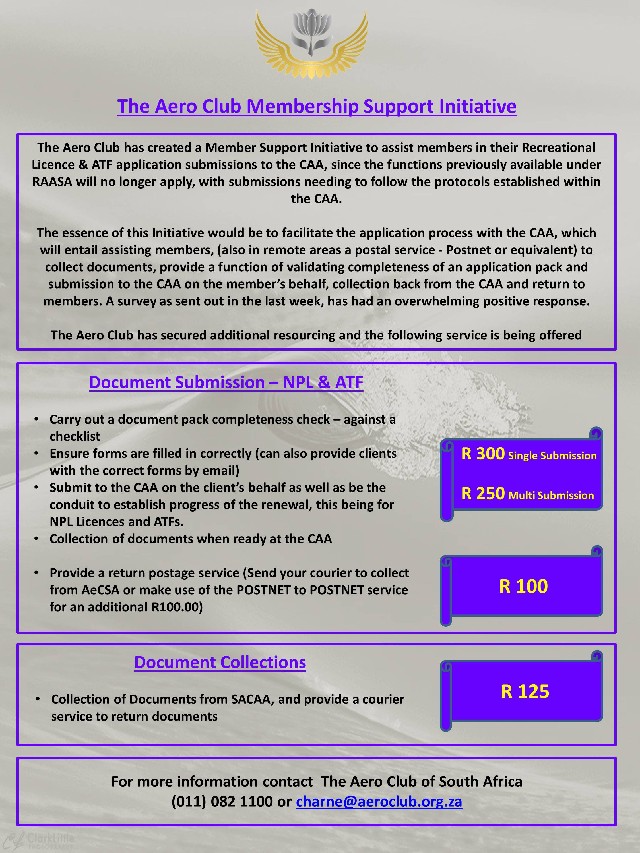

COVID 19 REGULATIONS, INITIATIVES AND AEROCLUB NEWS
AERO CLUB COMMUNIQUE JUNE 2020 # 2
Status on GA / RA flight operations in Level 3 - Update
As a further update from the communique sent out earlier in the week, there were two Captains of Industry meetings with the CAA this last week in preparation for phase 2 proposals under Level 3 of opening up aviation in which the Aero Club included further requests in allowing GA/RA to operate more freely given that there is very little burden on the system (our operations mainly outside controlled airspace) and low risk (operations at smaller airfields).
This phase 2 proposal was submitted to the DoT DG over the weekend, which although primarily focused on airline operations and a check point on how the airlines and the four airports have fared by mid-June, it did include our requests to consider further opening up of the GA / RA sector. We hope to engage with the DoT in the coming week on this.
In the interim, we can continue to carry out our maintenance related flights as well as positioning for maintenance flights which are working well with the Flight Authority system available off the Aero Club and CAASA websites. For Continued Airworthiness flights, the first aircraft are nearing their 28-day cycle, and thus owners can re-apply for their 2nd flight starting in this coming week.
We are also working at allowing us to carry out proficiency flights in our various disciplines and should have some news on this soon, as there is a collective concern about flying proficiency and the safety aspects related to this. It is being treated with some urgency.
As you will be aware, on Friday the Sports Ministry released a Gazette allowing professional sporting activities. This has resulted in confusion and consternation among our members. An audio clip related to model flying has done the rounds on social media. It needs to be made clear that no GA / RA flying is allowed under Level 3 as per the promulgated regulations set out in the Gazette - for reference is a copy as below. All flights that take place have to obtain prior approval from the CAA / DoT. We do recognise the frustrations & confusion there is right now and are doing our collective level best between all parties to get us airborne. Each allowance we get is a pathway to achieve a return back to normality.
A General Notice released by the CAA on 12th June that further extends the personnel licence / medical renewals beyond the initial date of 30 June as sent out during April.

MISASA - MICROLIGHT & SPORT AEROPLANE ASSOCIATION OF SOUTH AFRICA
Greetings everybody.
There was a decision made at the onset of COVID, that the Aero Club SA would be our voice piece and that media statements would be released from a single point - we have posted the Aero Club SA Communiques religiously for your benefit.
This post is about giving credit where credit is due. For some time now, there are a couple of persons in the industry that are hell bent on downplaying the role that Aero Club SA and its sub-sections such as MISASA, SAGPA and others have played. They have gone to great lengths to criticise & trample the efforts made with intense negativity and apportion EVERYTHING that has been achieved up to now solely to the credit of CAA. Total misinformation and I am curious if the folks at CAA that the team has collaborated so closely with would approve of these statements.
I mention MISASA & SAGPA purely because we have an incredibly good operational relationship. With this post though, I vouch for my committee, no, YOUR committee, for the unselfish commitments to provide & submit proposals that formed part of the major contribution from Aero Club SA - this all relevant to the opening of recreational aviation as we know it - from the maintenance flights right through to getting ATO's open.
We are definitely not beating our own chests. On the contrary, we are beating Aero Club SA's chest for its relevance and the role it has played and is still playing to get you, the member, back in the air. This load was most definitely shared by all mentioned. Sadly, those criticising also benefit from our efforts, but they are definitely exposed for their ungratefulness. I make special mention of Robert Paul Jonkers & Marthinus Potgieter, that have campaigned, championed, slogged, grafted, Zoomed, MS Teamed and Zoomed and all of this again... to achieve the results now known. Also, to CAASA's Kev Storie for his passionate and tireless efforts and contributions. Then, the CAA (Simon Segwabe, Mary Stephens, Neil de Lange et al) and everyone at the Authority, their roles and that has formed part of the strides and progress made - you folks have really risen to the occasion.
Finally, to my team (and in no particular order and who all have played a role) - Rowena Kraidy, Adrienne Leigh, Thelma Roberts-Boucher, Donald Hicks, Brett Bullet Mwanza Hickman, Dale De Klerk, Nico Willemse, Marius Nel, Stefan Coetzee, Pieter Kriel and Dawie du Toit - Thank You for efforts and time, often coupled vibrant discussions - we delivered and will continue doing so!
John Boucher - MISASA Chairman

SAAMA FLYING DURING LOCKDOWN
Dear SAMAA member
We have evidence of members purporting to have spoken to "someone" at CAA, their local police and the Dept of Sport, that model flying is not affected by the national lock-down regulations. These members may open themselves up to disciplinary action.
Please note that model flying at SAMAA-registered clubs is still prohibited under Alert Level 3 lock-down regulations and that no flying is permitted at SAMAA clubs until we receive notification from the Dept of Transport, the CAA, and the Aero Club of South Africa.
Government Gazettes 43433 and 43434 are perfectly clear, that only certain codes of professional non-contact sport have been given the green light for conditional activity.
Recreational aviation (and aeromodelling) MAY NOT YET RESUME ACTIVITY.
SAMAA Management is monitoring and engaging with the relevant authorities on an ongoing basis. However, we can only react once relevant information is gazetted.
We take note of all the frustrations and appreciate the loyal support, but we unfortunately have to ask for more patience.
Times will change:- let's not create unnecessary attention that might lead to a longer lock down.
Best regards, and keep safe.
The SAMAA Management team


CORONA VIRUS AND AVIATION EVENTS
Due to Covid 19 and regulations regulating travelling as well as restrictions controlling the number of people congregating together, no aviation events will take place in the foreseeable future. Pilot's Post will advise our readers as soon as this changes.
THURSDAY 18 JUNE 2020 @ 18h30
FLYING LEGEND TALK SHOW
EAA Talk Shows have joined the revolution and will be broadcasting the next Talk Show virtually. We have taken the time to put this together for our members and we hope that you will join us for an evening's entertainment. Don't miss this fantastic opportunity to listen in.
Hugh Pryor, now a retired pilot with a very busy and colourful career will be interviewed by Dr Mike Brown covering his career in the military, flying commercially, humanitarian career and recreational flying. Hugh writes for two aviation magazines and has written five books. If you have had an opportunity to read his column in a local aviation magazines, or if you have read any of his books, you will be familiar with his brilliant sense of humour, detailing an event in such a way that you can actually visualise what happened.
With over 18000 hours, he still has many more stories to tell and we look forward to listening to him and sharing these with Mike.
Please join us so that we have a "full house" on Thursday 18th June 2020 @ 18h30 SA time. EAA of SA will be sending a zoom connection link to all members the day before the event. As with the Auditorium, we will have "limited seating" so please connect on time and you will be given access from the waiting room on a first come, first served basis. We do hope to record this session as well, for a premier on YouTube at a later stage.
Hosted by : EAA of SA | EAA Auditorium | rsvp@eaa.org.za | 0832597691
1 July
EAA Chapter 322 monthly meeting due to Covid 19 will be a zoom meeting.
Contact Neil Bowden E-mail: neil1@telkomsa.net


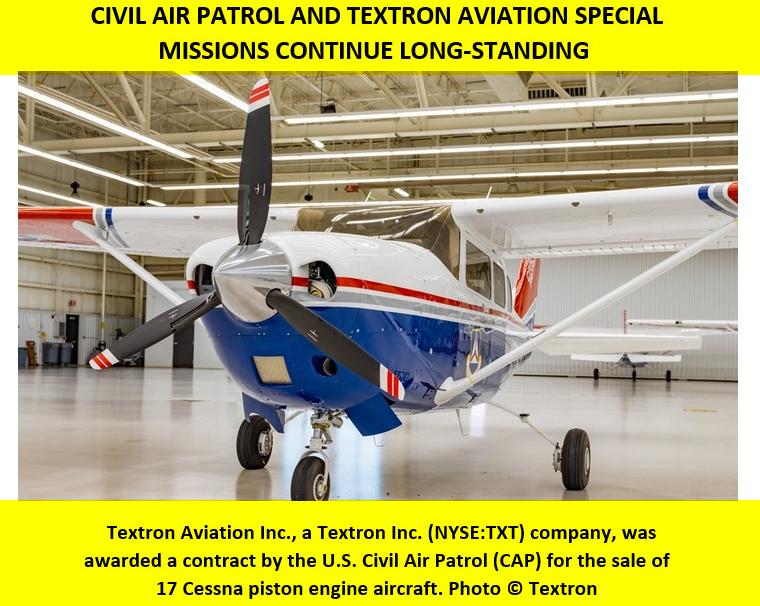
Using fiscal year 2020 funds, the CAP agreed to purchase 11 Skyhawk 172S, five Skylane 182T and one Turbo Stationair HD T206HD aircraft. The aircraft will join a fleet of nearly 550 Cessna aircraft currently owned and operated by the CAP.
As the Air Force Auxiliary, the CAP performs missions for government agencies and as a non-profit organization, they also serve states and communities. In fiscal year 2019, the CAP saved 117 lives and flew nearly 96,000 hours in their Cessna piston fleet. Today, the CAP is the world's largest Cessna piston operator.
In addition to the just announced contract, in 2019, the CAP ordered 19 aircraft and deliveries of those have begun, with two Turbo Stationair HD pistons already delivered.

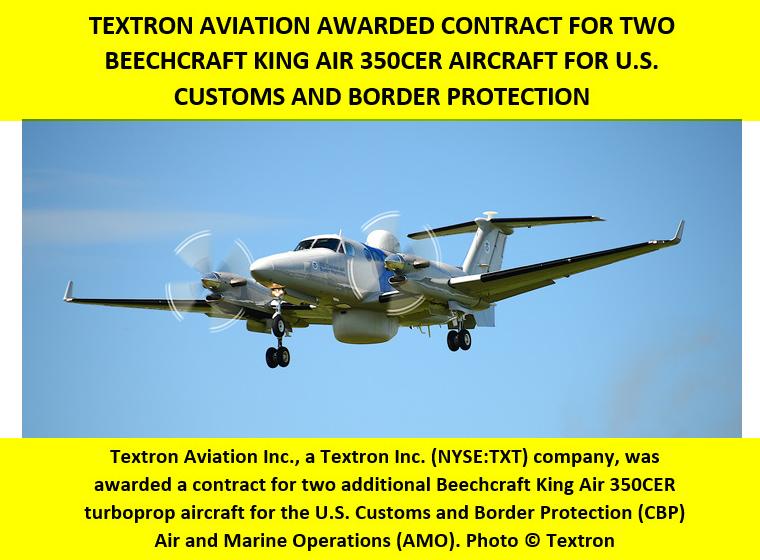
After mission modifications by Sierra Nevada Corporation, these two Multi-role Enforcement Aircraft (MEA) aircraft will join a fleet of 23 other King Air 350 aircraft used to safeguard the United States homeland as part of the coordinated application of CBP's aviation and maritime law enforcement resources.
"We are honoured the King Air 350CER continues to be the aircraft of choice to fill this critical mission need for the CBP," said Bob Gibbs, vice president, Special Mission Sales. "These aircraft can fly six-hour missions and can deploy to hot spots where multi-sensor patrols assist both ground and marine agents to detect, interdict and prevent acts of terrorism as well as the unlawful movement of people, illegal drugs and other contraband toward or across the borders of the United States."
CBP MEA is equipped with a sophisticated array of active and passive sensors, technical collection equipment and satellite communications capabilities that can be deployed for ground interdiction operations, air-to-air intercept operations and medium-range maritime patrols. The aircraft is operated by a crew of four, including two highly trained sensor operators who employ the mission equipment and coordinate the information flow to the ground.

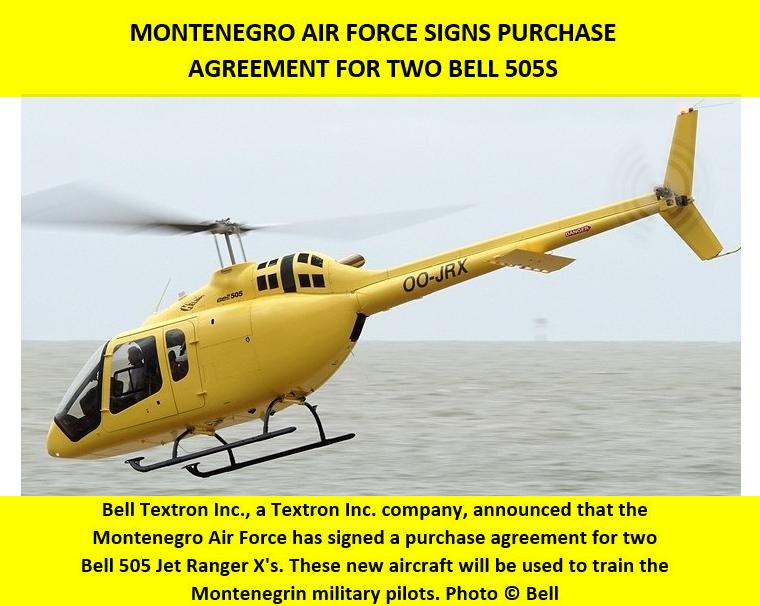
The agreement also provides that Bell will provide training for three pilots in France and eight technicians at its Bell Training Academy in Fort Worth, TX. The helicopters will be delivered out of our Bell-owned service centre in Prague.
The Bell 505 continues to have major success within Europe and other parts of the world. The aircraft includes a high-tech flight deck and adaptable cabin design making it extremely cost-competitive and capable for any challenge. With the latest integrated Garmin avionics suite and dual channel FADEC, the aircraft provides increased situational awareness and safety allowing pilots to focus on training.

With a speed of 125 knots (232 km/h) and useful load of 1,500 pounds (680 kg), the Bell 505 is designed to be safe and easy to fly while providing significant value to the operator. The customer-driven design of the aircraft places safety, performance and affordability at the forefront, blending proven systems with advanced technology and a sleek, modern design.
The Bell 505s will be manufactured by Bell Textron Canada at their facility in Mirabel, Quebec. The sale was facilitated by the Canadian Commercial Corporation through a government-to-government contract. CCC supports the growth of international trade by helping Canadian exporters gain access to foreign government procurement opportunities.

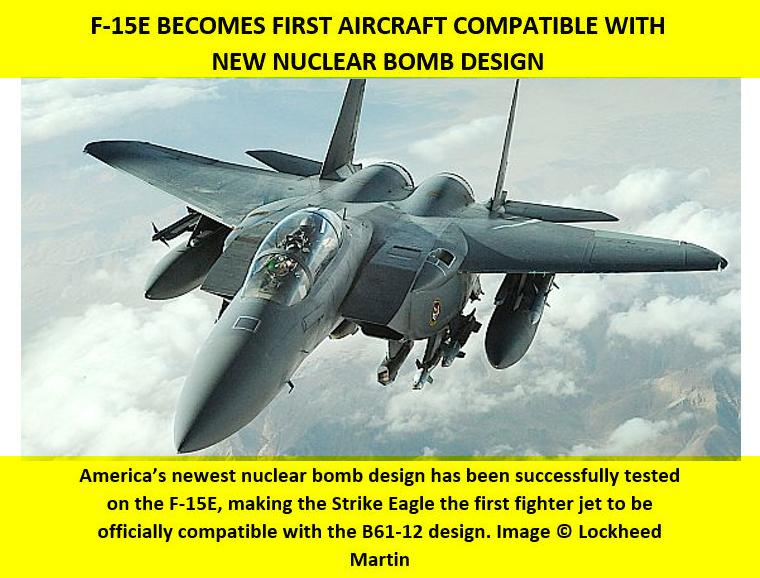
Two test flights were flown twice in March at the Tonopah Test Range in Nevada, according to a release by Sandia Labs. The mock weapon was released on one test at about 1,000 feet and at nearly the speed of sound, while a higher-altitude test occurred at around 25,000 feet; both tests hit the target as designed.
The B61-12 program will replace the B61-3, -4, -7 and -10 nuclear gravity bomb variants with a new warhead design. The warhead is being developed and produced by the National Nuclear Security Administration, a semi-independent agency located within the Department of Energy, while the Pentagon is developing new tail kit assemblies for the design.
"The success of these tests is a major milestone on the path to full rate production and the B61-12's initial operation capability on the F-15E in the coming years," Brig. Gen. Ty Neuman, NNSA's principal assistant deputy administrator for military application, said in a statement. "Once delivered, this capability will underpin our nation's deterrent and strengthen our NATO partnerships."


The Bell Boeing [NYSE:BA] V-22 team recently delivered its 400th aircraft, a CV-22 for U.S. Air Force Special Operations Command.
The first production V-22 was delivered on May 24, 1999 and today, deliveries occur under the Multi-year Procurement III contract valued at $5 billion. That contract runs through 2024 and includes variants for the Marines, Air Force, and Navy, as well as the first international customer, Japan.

The V-22 takes off, hovers, and lands like a helicopter yet flies long distances like a turboprop aircraft. The CV-22 variant performs special operations missions, including infiltration, extraction and resupply, that conventional aircraft can't. The Marine Corps variant, the MV-22B, provides the safe and reliable transportation of personnel, supplies and equipment for combat assault, assault support and fleet logistics. The Navy variant, the CMV-22B, is the replacement for the C-2A Greyhound for the carrier onboard delivery mission.
The V-22 has been deployed in a variety of combat, special operations and humanitarian roles since becoming operational in 2007. Having accumulated more than 500,000 flight hours, the V-22 is safe, survivable and combat proven. Bell Boeing's post-delivery support includes maintenance, modifications and supply chain expertise, innovative data insights and more than 160 field operations employees embedded at customer locations.

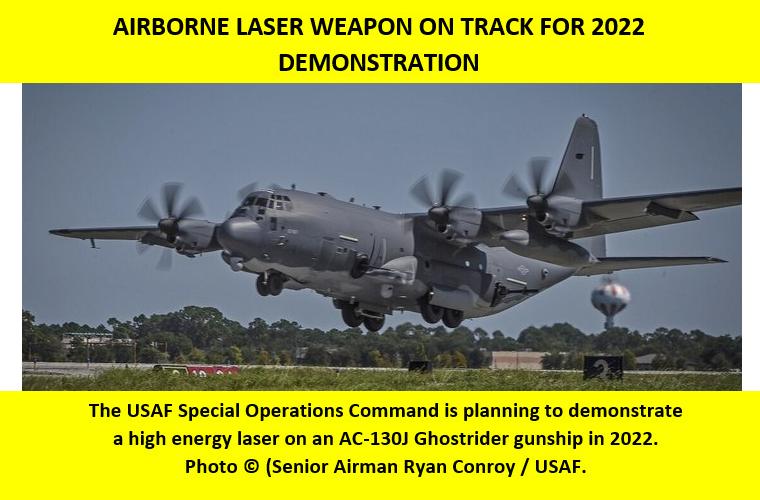
The 60-kilowatt high energy laser will be mounted on an AC-130J Ghostrider, gunship, which already boasts a 30mm side-firing chain gun, a 105mm cannon, AGM-176A Griffin laser guided missiles, wing-mounted GBU-39/B GPS-guided and GBU-39B/B laser-guided Small Diameter Bombs.
Unlike those kinetic weapons, the offensive high energy laser would be able to disable enemy systems stealthily. As envisioned, a Ghostrider could take out several aircraft, defensive weapons and sensors with its silent, unseen laser weapons before the enemy even knew they were under attack. There's no explosion, sounds or flashes of lights to alarm the targets. An enemy combatant would only realize what had happened once they attempted to use a system that had already been disabled.
At the virtual Special Operations Forces Industry Conference 13 May Col. Melissa Johnson, the program executive officer for fixed wing at U.S. Special Operations Command, acknowledged the Department of Defence's laser development efforts have not been steady over the years.


Airflow's eSTOL concept includes distributed electric propulsion, a "Virtual Tailhook" pilot assistance system and an aerial operating system that allows operators to manage aircraft in real time.
Based in the San Francisco Bay Area, Airflow is initially targeting the middle-mile logistics market with an aircraft that can carry one pilot and 500 pounds (225 kilograms) up to 250 miles (400 kilometres). Airflow says its eSTOL will be able to operate in poor weather and take off and land in just 150 feet (45 meters), enabling the transfer of time-sensitive cargo directly between warehouses throughout the day and night. The company predicts its airplanes will be four times faster than trucks, with a third of the hourly operating costs of comparable helicopters or eVTOLs.
They decided that, for use cases where at least 300 feet of runway is available, eSTOL aircraft offer lower development costs, operating costs and noise. Because eSTOL aircraft can be certified under existing Part 23 regulations, they also pose less certification risk than eVTOLs, which must be certified using a more complicated and expensive process that is not yet fully defined. Airflow estimates it can develop and certify an eSTOL aircraft for around $200 million, versus more than $700 million for an eVTOL aircraft.

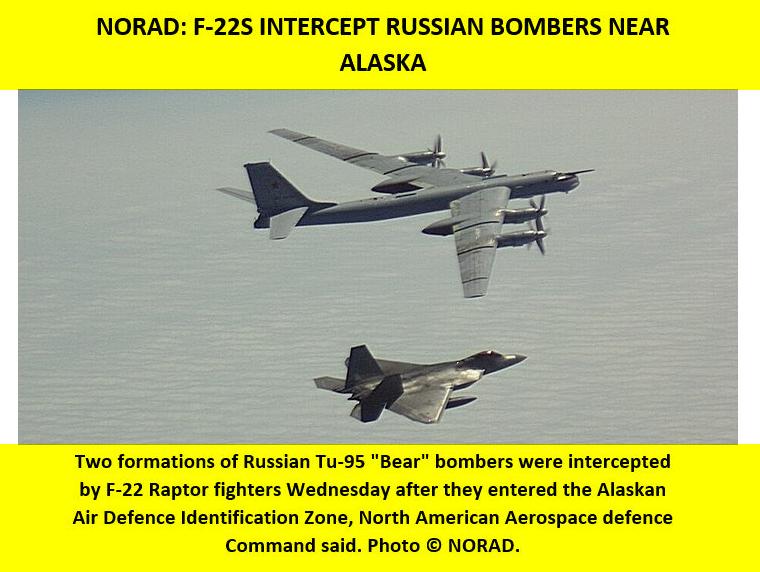
"Intercepting multiple Russian aircraft demonstrates NORAD forces' readiness and capability to defend the homeland 24 hours a day, seven days a week, 365 days a year," NORAD commander Gen. Terrence O'Shaughnessy said in a tweet. "Flying air patrols protects the approaches to our nations and sends a clear message we continue executing our homeland defence missions with the same capability and capacity we always bring to the fight."
NORAD said both formations remained in international airspace at all times, and did not enter the United States' airspace. The second formation, which also included an A-50, came within 32 nautical miles of Alaska, NORAD said.
Intercepts of Russian aircraft in the zone around Alaska happen fairly regularly and have occurred multiple times in recent months. In March, for example, U.S. and Canadian aircraft intercepted two Russian reconnaissance aircraft that were watching and loitering around a U.S. submarine exercise known as ICEX.
NORAD said its F-22s were supported by an E-3 Airborne Warning and Control System, or AWACS, and KC-135 Stratotankers.

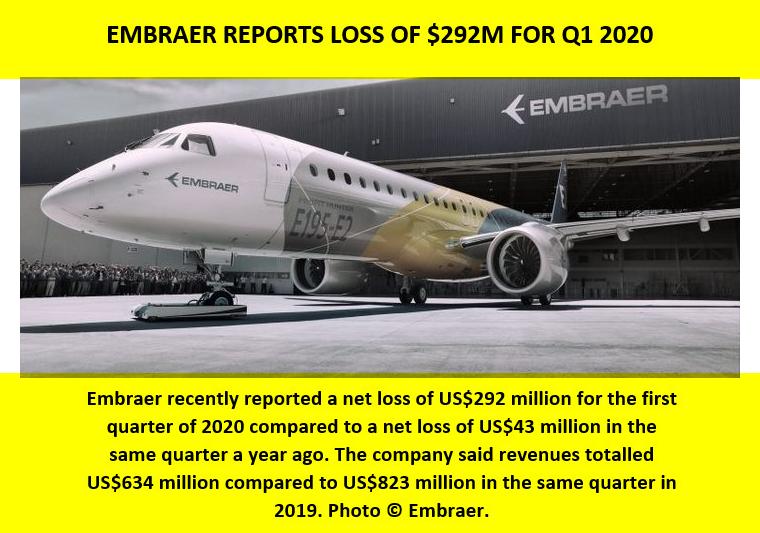
The company said the global COVID-19 pandemic halted commercial jet production during January and was also halted to ready the company for its planned joint venture with Boeing that was to have taken control of the commercial jet program. Boeing cancelled the US$4 billion deal and both sides blame each other for its failure.
Embraer said its commercial aircraft revenues fell 50 percent to US$141m versus US$281 million last year. It added that its business jet segment is recovering somewhat, with first-quarter revenue this year up 11 percent to US$130 million compared to US$117 million in the first quarter of 2019, saying "high-end deliveries are now strong after several years of a slump".
Separation costs for the cancelled Boeing joint venture during the first quarter was US$22 million, while the company also said the first quarter results included costs of US$55 million in "special items due to the impacts of COVID-19". Embraer lowered the fair value of its stake in Republic Airways and made bad debt provisions for weak airliner customers of US$33 million.
Arbitration proceedings with Boeing have started for the cancelled commercial airplanes joint venture agreement and the KC-390 contribution agreement. Embraer said in the quarterly presentation call it would be open to new cooperation agreements but had nothing new to tell on the subject.
The company said it delivered five commercial jets and nine executive jets (five light/four large) in the first quarter and Embraer's firm-order backlog at the end of the quarter was US$15.9 billion.



Canada, Ottawa River near Arnprior Airport, Renfrew County: A Champion 7GCB Challenger with only the pilot on board and a Cessna Cessna 172M Skyhawk with four on board was involved in a mid-air collision over the Ottawa River near Arnprior in Ontario. The Challenger sustained substantial damage from the collision and subsequent impact with the waters of the Ottawa River and the sole pilot onboard received minor injuries. The Skyhawk involved in the mid-air collision landed at nearby Arnprior Airport (CNP3), Arnprior, Ontario, having sustained minor damage. The four occupants onboard the Skyhawk were not injured.
USA, Sioux Falls Regional Airport: A Mitsubishi MU-2B-60 Marquise operated by McNeely Charter Service with only the pilot on board crashed on take-off from Sioux Falls Regional Airport, South Dakota, USA. The aircraft sustained substantial damage. The pilot died in the crash. The pilot originally departed from Everett, Washington, to transfer cargo to Huron, but he diverted to Sioux Falls Regional Airport because of thunderstorms in the Huron area. The pilot was taking off to resume his flight to Huron.

Iraq, Camp Taji Airbase, near Baghdad: A USAF Lockheed C-130H Hercules operated by the Wyoming ANG suffered a runway excursion and crashed into a concrete wall. On board were 7 crew and 26 passengers. Four occupants were injured. There was a post-crash fire and the aircraft was damaged beyond repair.
USA, Kline Kill Airport: A Waco YMF-F5C operated by Kinderhook Aviation LLC with two on board clipped a runway adjacent tree and impacted trees during a take-off attempt at Kline Kill Airport (NY1), Ghent, New York. The biplane sustained unreported but apparent substantial damage and the two occupants onboard were not injured.
USA, Mandan Municipal Airport: A Van's RV-8 with only the pilot on board aircraft impacted airport terrain during a take-off attempt at Mandan Municipal Airport (Y19), North Dakota. The airplane sustained unreported damage and the sole pilot onboard received fatal injuries.



At the end of World War II, Adm. Chester W. Nimitz, the Chief of US Naval Operations, ordered the formation of a flight demonstration team to keep the public interested in Naval Aviation and boost Navy morale. Lt. Cmdr. Roy "Butch" Voris, a veteran flying ace with eight air victories to his credit, was chosen as the new flight team's commander and given the task of selecting the rest of the pilots and ground staff.
Flying the Grumman F6F Hellcat, the main Navy fighter during WWII, the group's first aerial demonstration took place less than a year later on 15 June 1946 at Jacksonville's Craig Field.
For the first month of its existence, the flight demonstration team flew without a name. Officers at Navy Headquarters had proposed "Navy Blue Lancers," a moniker the pilots rejected. As the group prepared for a show in New York that July, Lt. Maurice "Wick" Wickendoll came across an advertisement in the New Yorker for that city's famous Blue Angel nightclub. The first demonstration under the Blue Angels name was a show in Omaha, 19 July 1946.
By the end of the 1940s, the Blue Angels were flying their first jet aircraft, the Grumman F9F-2 Panther. In response to the demands placed on Naval Aviation in the Korean Conflict, the team reported to the aircraft carrier USS Princeton as the nucleus of Fighter Squadron 191 (VF-191), "Satan's Kitten," in 1950.

|
                         |























